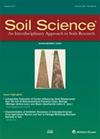Whole-soil warming decreases abundance and modifies the community structure of microorganisms in the subsoil but not in surface soil
4区 农林科学
Q2 Agricultural and Biological Sciences
引用次数: 4
Abstract
Abstract. The microbial community composition in subsoils remains understudied, and it is largely unknown whether subsoil microorganisms show a similar response to global warming as microorganisms at the soil surface do. Since microorganisms are the key drivers of soil organic carbon decomposition, this knowledge gap causes uncertainty in the predictions of future carbon cycling in the subsoil carbon pool (> 50 % of the soil organic carbon stocks are below 30 cm soil depth). In the Blodgett Forest field warming experiment (California, USA) we investigated how +4 ∘C warming in the whole-soil profile to 100 cm soil depth for 4.5 years has affected the abundance and community structure of microorganisms. We used proxies for bulk microbial biomass carbon (MBC) and functional microbial groups based on lipid biomarkers, such as phospholipid fatty acids (PLFAs) and branched glycerol dialkyl glycerol tetraethers (brGDGTs). With depth, the microbial biomass decreased and the community composition changed. Our results show that the concentration of PLFAs decreased with warming in the subsoil (below 30 cm) by 28 % but was not affected in the topsoil. Phospholipid fatty acid concentrations changed in concert with soil organic carbon. The microbial community response to warming was depth dependent. The relative abundance of Actinobacteria increased in warmed subsoil, and Gram+ bacteria in subsoils adapted their cell membrane structure to warming-induced stress, as indicated by the ratio of anteiso to iso branched PLFAs. Our results show for the first time that subsoil microorganisms can be more affected by warming compared to topsoil microorganisms. These microbial responses could be explained by the observed decrease in subsoil organic carbon concentrations in the warmed plots. A decrease in microbial abundance in warmed subsoils might reduce the magnitude of the respiration response over time. The shift in the subsoil microbial community towards more Actinobacteria might disproportionately enhance the degradation of previously stable subsoil carbon, as this group is able to metabolize complex carbon sources.全土变暖降低了底土中微生物的丰度并改变了微生物的群落结构,而表土中没有
摘要地下土壤中的微生物群落组成仍未得到充分研究,并且在很大程度上尚不清楚地下土壤微生物是否表现出与土壤表面微生物相似的对全球变暖的反应。由于微生物是土壤有机碳分解的关键驱动因素,这种知识差距导致对地下碳库未来碳循环预测的不确定性(> 50%的土壤有机碳储量低于30厘米土壤深度)。在布洛杰特森林(美国加利福尼亚州)的田间增温实验中,我们研究了4.5年+4°C的增温对100厘米土壤深度的全土壤剖面的影响,研究了微生物的丰度和群落结构。我们使用了基于脂质生物标志物(如磷脂脂肪酸(PLFAs)和支链甘油二烷基甘油四醚(brGDGTs))的散装微生物生物量碳(MBC)和功能微生物群的代理。随着深度的增加,微生物生物量减少,群落组成发生变化。结果表明,土壤(30 cm以下)中PLFAs浓度随升温而下降28%,而表土中PLFAs浓度不受影响。磷脂脂肪酸浓度随土壤有机碳的变化而变化。微生物群落对变暖的响应与深度有关。放线菌的相对丰度在温暖的底土中增加,并且底土中的革兰氏+细菌使其细胞膜结构适应了温暖诱导的胁迫,这是由前支与等支plfa的比例所表明的。我们的研究结果首次表明,与表土微生物相比,底土微生物受变暖的影响更大。这些微生物反应可以用观察到的暖地土壤有机碳浓度下降来解释。随着时间的推移,温暖的底土中微生物丰度的减少可能会降低呼吸响应的幅度。由于放线菌群能够代谢复杂的碳源,因此底土微生物群落向放线菌群的转变可能不成比例地增强了以前稳定的底土碳的降解。
本文章由计算机程序翻译,如有差异,请以英文原文为准。
求助全文
约1分钟内获得全文
求助全文
来源期刊

Soil Science
农林科学-土壤科学
CiteScore
2.70
自引率
0.00%
发文量
0
审稿时长
4.4 months
期刊介绍:
Cessation.Soil Science satisfies the professional needs of all scientists and laboratory personnel involved in soil and plant research by publishing primary research reports and critical reviews of basic and applied soil science, especially as it relates to soil and plant studies and general environmental soil science.
Each month, Soil Science presents authoritative research articles from an impressive array of discipline: soil chemistry and biochemistry, physics, fertility and nutrition, soil genesis and morphology, soil microbiology and mineralogy. Of immediate relevance to soil scientists-both industrial and academic-this unique publication also has long-range value for agronomists and environmental scientists.
 求助内容:
求助内容: 应助结果提醒方式:
应助结果提醒方式:


